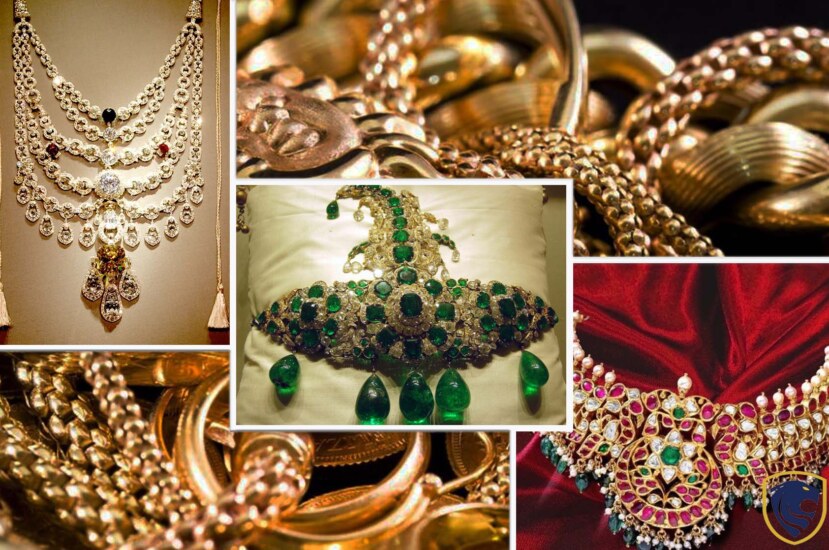When it comes to jewels no culture can compete with India. Indians love their gold jewels that are decorated with gems and valuable diamonds. This fact can be proved thoroughly when we take a look at the jewelry pieces that are worn by royal Indians.
A layered ruby choker
Cartier designed a tiered ruby necklace that is decorated with diamonds and pearls for the Maharani of Patiala, Maharani Vimla Kaur, in 1931. The necklace was given the name Patiala Ruby Choker. The necklace’s centerpiece is rows of rubies accompanied by gems and pearls on the sides. The drop pendant that topped the final layer of the necklace, was particularly large due to the surrounding diamonds and pearls.
From 1900 until 1938, Bhupinder Singh, Maharaja of Patiala (1891-1938), governed the princely kingdom of Patiala. Bhupindar Singh was most known for his opulent lifestyle. He believed in extravagance and had an overwhelming desire for ladies, cuisine, vacations, sports, politics, and everyday indulgences. According to legends he had a procession of over twenty Rolls-Royces that would transport the Maharaja and his innumerable wives, advisers, servants, and employees when they traveled around Europe.

A layered ruby choker
The Maharaja handed Cartier many jewels from his coffers in the middle of the 1920s. He wanted them to reset and rework. He commanded jewelry to be manufactured for himself, his numerous wives, and concubines. Moreover, he preferred platinum over gold when it comes to jewelry making.
The necklace ultimately underwent a reset and restyle to adhere to changing fashions, just like many gems from the 1920s and 1930s. Cartier repaired the necklace in 2012 and had it re-strung according to its original pattern. The “Patiala Choker,” is regarded by the company as one of the most significant necklaces ever created. Also, it is one of the greatest connections that formed during this time and sums up the passion between the East and West in the early 20th century.
Star of the South
One of the most famous royal jewels in the world is the enormous Star of the South necklace worn by Maharani Sita Devi of Baroda. The 128-carat Star of the South diamond lies at the center of a three-tiered diamond necklace. It also included a 78.5-carat English Dresden diamond, according to TOI. According to the daily, the Gaekwar of Baroda paid Rs 20 million for the diamond.

Star of the South
According to the story, Lady Sitadevi’s ancient Baroda anklets were transformed into a stunning necklace by her close friend and designer Harry Winston in 1953. Because she sold them to him. Wallis Simpson, the Duchess of Windsor, was rumored to have purchased the necklace. The Duchess wore this reused jewelry to a banquet in New York in 1957. And it is said that one of the attendees was Lady Sitadevi herself. She casually remarked, “The gems looked nicer on my feet! The Duchess was very embarrassed by this. So, she quickly sent the necklace back to Winston to express her disgust.
A magnificently large diamond crown
During his reign, Jagatjit Singh, the Maharaja of Kapurthala, was regarded as a fashionista. In addition to the diamond crown shown here, it was thought that he also had several other custom-made ones. Also, his outfits would always be adorned with complementary gems and the Star of India brooch, which the British Crown bestows upon chosen Indian monarchs.
From 1926 on, the Maharaja continued to use this decorative headpiece in a number of his court pictures. Moreover, this ornament’s biggest hexagonal emerald is thought to weigh about 117.40 carats. It was one of the first and most well-known commissions Cartier had gotten from Indian royalty.

A magnificently large diamond crown
The jewelry is studded with 19 emeralds of various shapes, sizes, and dimensions. In addition, pearls and white diamonds were used in this jewel. Later, Maharaja had the emeralds re-set into this contemporary and more masculine jewel from his extensive collection of antiques and hereditary dynasty jewels. The Maharaja of Kapurthala has been seen wearing this regal emerald gem on two distinct occasions. For instance, he wore it in the time during King George the V of England’s Silver Jubilee in 1935. Also, it was seen at King George VI’s coronation in 1937.
Kundan haar
This exquisite royal necklace had 2,930 diamonds in total. The centerpiece was a 234-carat yellow “De Beers,”. Also, that was the seventh-largest diamond in the world. In 1928, Cartier Paris also produced this magnificent item for Maharaja Bhupinder Singh of Patiala. The incredible jewelry was made of Burma rubies, zircons, and citrine. In addition, topaz, platinum, zirconia, diamonds, and topaz were used to decorate this item.

Kundan haar
Diamond dastar
The sole surviving child of Raja Bhairon Singhji Saheb Bahadur and his wife, Rani Birad Kanwarji Sahiba, Ranjit Singh was the thirteenth Maharaja of Ratlam. With the death of his father on January 28, 1864, he took over the country. He became a ruler before reaching adulthood and being granted complete authority. He first ruled under a Council of Regency under the leadership of Khan Bahadur Mir Shahamat Ali.
H.H. Jhaliji Maharani Shrimant Raj Kunverba Sahiba, his first wife, his second wife, and his third wife were all wedded to him between 1878 and 1889. On January 20, 1893, in Ranjit Bilas Palace in Ratlam, he passed away from pneumonia. He left behind a son and two daughters.

Diamond dastar
You can identify the grandson of Sayajirao III Gaekwad of Baroda wearing an outstanding headpiece by looking at the wedding photos. Because it is made with complex sarpattis made of diamonds, pearls, and other priceless jewels. Moreover, the Maharaja Shrimant Sir Ranjit Singhji Sahib Bahadur of Ratlam may be seen sporting pearl earrings, a pearl choker, and a Kundan haar consisting of diamonds, pearls, and other precious stones. If you look closely, you can see that the Maharaja’s angarkha is also decorated with a gold thread and sequin design.
Diamond serpech
The magnificent diamond serpech has been worn by Maharaja Duleep Singh of Lahore. He was the final Monarch of the Sikh realm. It was essentially a turban-specific accessory for him. The center of each of the three plumes, which are fashioned completely of diamonds, also has a brilliant emerald. You can see that the Maharaja had exquisite taste in jewelry just by glancing at this photograph, which includes earrings, layered neckpieces, and bazubandhs.

Diamond serpech
Ranjit Singh, a great “Lion of Lahore” who ruled Punjab for for 50 years, had a son named Dulip. Assassinations and power battles dominated after Ranjit’s passing. But the boy’s mother, Rani Jindan, eventually succeeded in having him declared maharaja in 1843. Yet her brother Jawahir Singh and her Brahman lover still held the real authority. As the First Sikh War against the British broke out in 1845, the Sikh army had quadrupled in size from that in 1839 to more than 70,000 soldiers. It had also fired all of its foreign officers. Dulip was designated a ward of the British Indian government. Also, he was acknowledged as the maharaja of a smaller Sikh kingdom.




